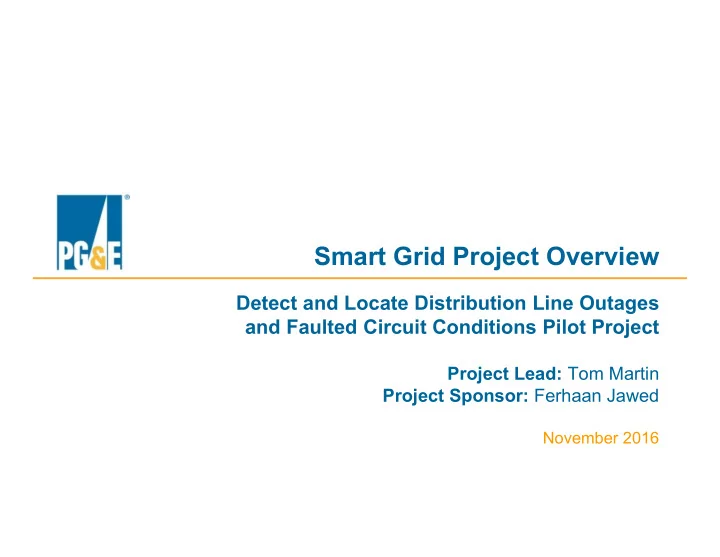

Smart Grid Project Overview Detect and Locate Distribution Line Outages and Faulted Circuit Conditions Pilot Project Project Lead: Tom Martin Project Sponsor: Ferhaan Jawed November 2016
Project Background & Value Proposition One of four pilots approved by the CPUC in March 2013 to demonstrate the value and challenges of deploying new Smart Grid technologies. Supporting the Smart Grid Vision • Unleashes the power of data and analytics to provide faster fault location and detection. • Takes advantage of new data sources such as wireless communicating line sensors. • Supports increased distributed generation (DG) Supporting Affordability • Faster fault identification and location, reduces patrol time. • Uses new and existing data sources. • Low cost implementation. 2
What is Calculated Fault Location? Calculated Fault Location (CFL) is a mathematical method of locating faults based on Ohm’s Law. Voltage Current Resistance Using the knowledge of this relationship between voltage, current, and resistance, CFL calculates the probable distance from the substation to the fault. 3
The Problem with Calculated Fault Location CFL may return too many possible locations due to branching on the circuit. Or incorrect location due to lack of measurement data or incorrect system modeling The Solution: Use data from wireless communicating line sensors, increased data from substation circuit breakers, and voltage data to improve the results. 4
Fault Location Approaches CFL only Voltage only Line Sensor only All locations are mathematically correct Accuracy dependent on device location Accuracy dependent on device location 5
Layering Analytics & Data Combined results Actual fault location Filtered result shown to operators When data from all methods are combined, the result is extremely accurate and valuable 6
High Impedance Faults • High impedance faults result when fault conditions occur, but contact is made which restricts the flow of fault current – examples are: • Open electrical conductor • Wires broken by contact • Other wire failures • Difficult to identify using traditional overcurrent protection devices because they don’t produce enough fault current to be detected • PG&E investigated combining indications from SmartMeters™ with other analytics to determine whether and where a high impedance fault occurred 7
High Impedance Fault Location SmartMeters™ can pinpoint open jumper, broken wire, other open or downed wire conditions Condition SmartMeter FULL VOLTAGE on (SM) Indication SM Wire down No issues Fully responsive location Partial SM indicates voltage voltage issue Fully out No response PARTIAL VOLTAGE on SM Combining arc detection data from line sensors or substation relays indicates an energized wire down 8
Fault Anticipation • PG&E investigated using waveforms from line sensors and SCADA reclosers to identify incipient conditions, such as vegetation contact with lines. • Goal: Find faults before they occur. • Will only be operationally useful when an extensive library of waveform signatures is developed to provide rapid identification of conditions. Possible arcing Load pickup 9
Achievements • Calculated Fault Location (CFL) can further reduce fault restoration and patrol time by at least 1.4% beyond the 12.2% reduction attributed to line sensors. • Demonstrated that including fault voltage measurements often improves CFL location accuracy by 10% or more. • Demonstrated that fault voltage measurements alone can provide location of faults, often more accurately than impedance calculations. • Identified high impedance faults using SmartMeter™ data – when combined with waveforms, identified energized wire down situations. • Identified damaged fuses that required replacement to avoid outages. • Fault analytics found a failing capacitor bank; difficult to identify visually. • Identified vegetation intrusion into a capacitor bank that was triggering momentary outages. 10
Recommend
More recommend